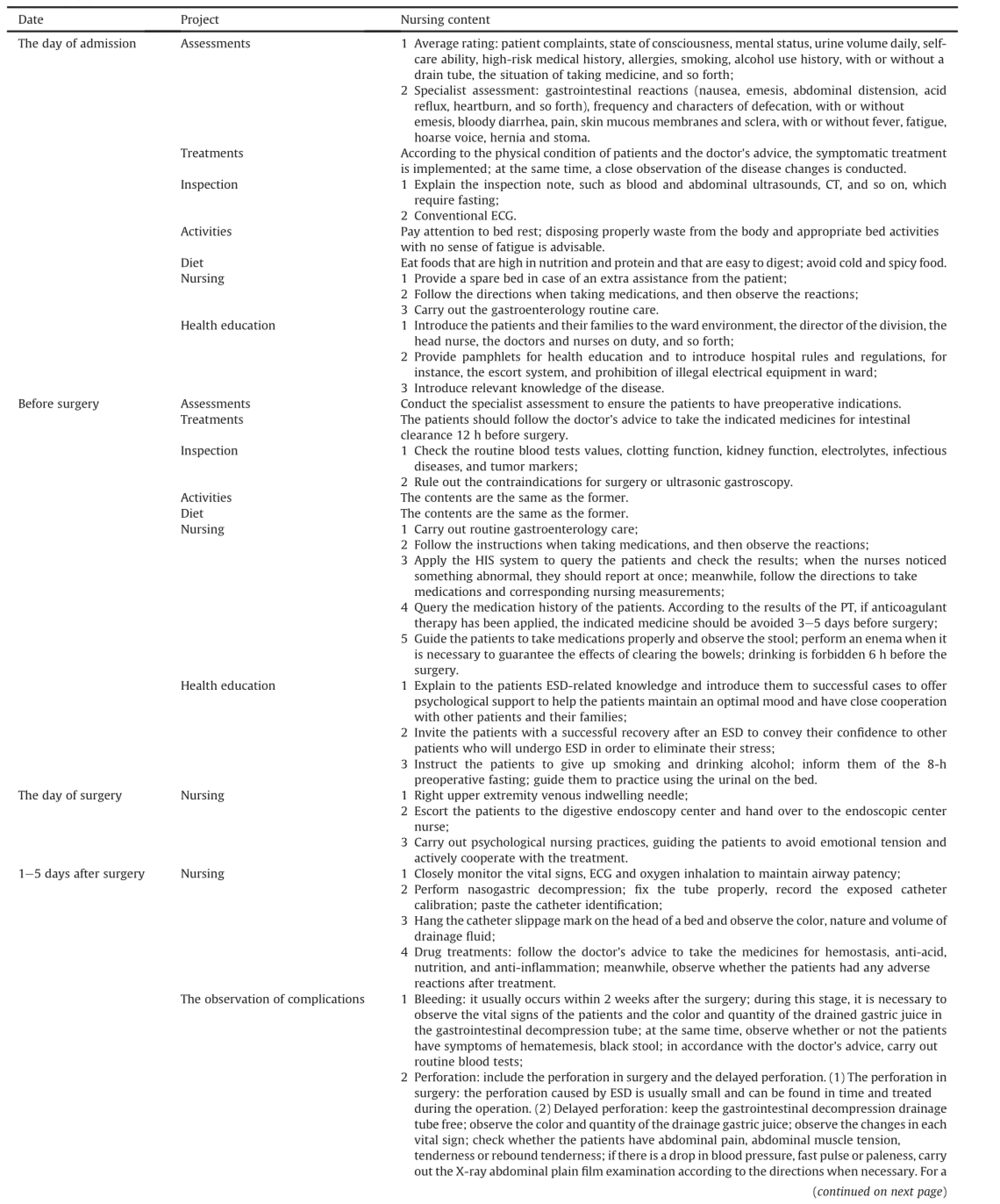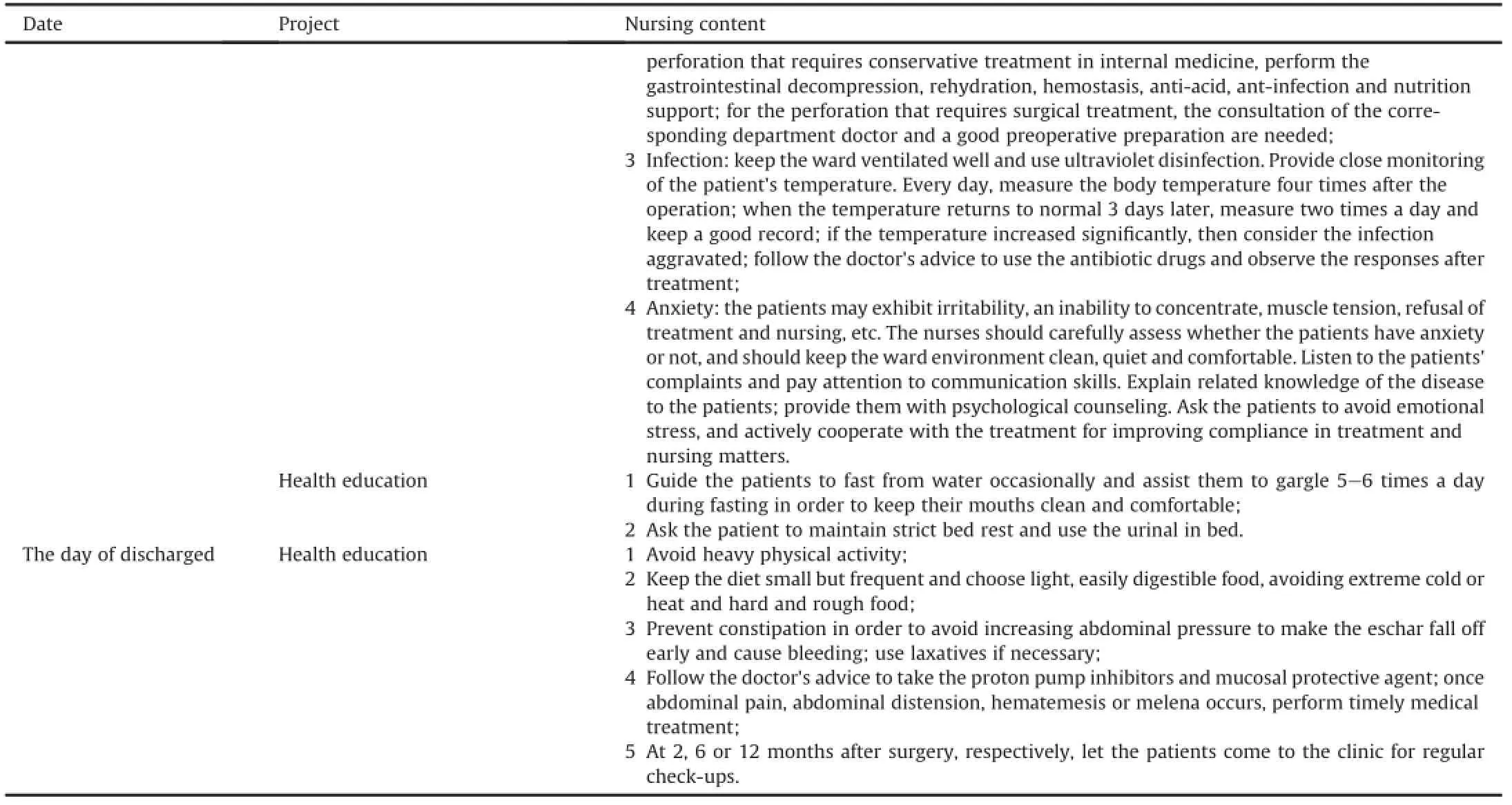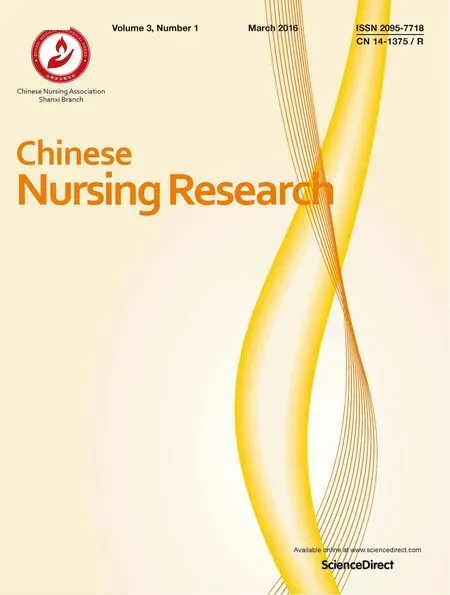Clinical nursing path after endoscopic submucosal dissection reduces the risk of postoperative complications☆
Xi Bi,Jun-Ping Wng,Ln Ming,Y-Jie Xu,Xi SunDeprtment of Gstroenterology,The First Affilited Hospitl of Zhengzhou University,Zhengzhou,Henn 450052,ChinZhengzhou University School of Nursing,Zhengzhou,Henn 450052,Chin
Original article
Clinical nursing path after endoscopic submucosal dissection reduces the risk of postoperative complications☆
Xia Baia,*,Jun-Ping Wanga,Lan Minga,Ya-Jie Xua,Xia SunbaDepartment of Gastroenterology,The First Affiliated Hospital of Zhengzhou University,Zhengzhou,Henan 450052,ChinabZhengzhou University School of Nursing,Zhengzhou,Henan 450052,China
A R T I C L EI N F O
Article history:
Received in revised from
15 March 2015
Accepted 23 September 2015
Available online 21 March 2016
ESD
Clinical nursing path
Complications
Risk
ABSTRACT
Objective:To investigate the effect of the nursing path on postoperative complications after endoscopic submucosal dissection(ESD).
Method:Patients'nursing paths for ESD were established based on a systematic analysis of relevant literature,previous clinical procedures and consultation with chief physicians from a gastroenterology department.Forty patients were divided into the observation or control group and were assigned to follow the nursing path or the conventional path after an ESD,respectively.Next,the incidence of postoperative complications of these two groups was measured,primarily assessing the occurrences of bleeding,perforation,infection,and anxiety.
Results:The incidence of complications after ESD in the observation group was remarkably lower than that of the control group(P<0.05).
Conclusion:The nursing path for ESD has a positive role in reducing certain frequent complications that occur after ESD,particularly infection and anxiety;in addition,the nursing path optimizes nursing care in patients with gastrointestinal stromal tumor.
©2016 Shanxi Medical Periodical Press.Production and hosting by Elsevier B.V.This is an open access article under the CC BY-NC-ND license(http://creativecommons.org/licenses/by-nc-nd/4.0/).
1.Introduction
Early diagnosis of a gastrointestinal abnormality within the mucosa or submucosa is considered to be associated with the advancement of endoscopic skills,including endoscopic mucosal resection(endoscopic mucosal resection,EMR)and endoscopic submucosal dissection(ESD),and treatment with conventional surgery has gradually been replaced by minimally invasive operations under endoscopy,especially for early cancerous alterations buried in the gastrointestinal mucosa or submucosa.1
An early-identified gastrointestinal neoplasia within mucosal lesionswithadiameteroflessthan2cmisconsideredeligibleforEMR under gastric endoscopy;however,an EMR performed on lesions of more than 2 cm is more likely to result in a deviation of pathological valuation and local recurrence.First appearing in Japan for earlydiagnosed gastric carcinoma,endoscopic submucosal dissection(ESD),a derivative of EMR,has been demonstrated as beneficial for removing mucosal lesions larger than 2 cmwith a higher cure rate.2 Inaddition,theapplicablescopeofESDhasextendedtothecomplete resection of non-invasive lesions in the esophagus,stomach and intestinal tract,which demonstrates the advantages of less trauma,significantcurativeeffectandafastrecovery;however,patientsafter ESD could bear a higher potential risk for post-operative complications,including bleeding,perforation,or infection without a standardized nursing process,ultimately leading to a poor prognosis,longer hospitalization and more expenses.3,4
Thus,a standard clinical nursing path has long been urgently required to optimize the service quality of nursing for hospitalized patients.In recent years,the presence of King's theory has been clarified to increase the effectiveness of nursing.5Therefore,we formulated a suitable nursing path after ESD based on King's theory,showing the benefits related to nursing efficiency and clinical practice in our department.Accessing this creative nursing path makes the work of nurses more efficient and structural;concomitantly,patients who realize the nursing plan or goals scheduled in a standard nursing path are more willing toactively participate in the recovery process,which could not only strengthen their self-care consciousnessandabilitybutalsoachievebetternursingconsequences.Our study chose gastric stromal tumor patients as the research subjects,and the results are summarized below.
http://dx.doi.org/10.1016/j.cnre.2015.09.008
2095-7718/© 2016 Shanxi Medical Periodical Press.Production and hosting by Elsevier B.V.This is an open access article under the CC BY-NC-ND license(http:// creativecommons.org/licenses/by-nc-nd/4.0/).

Table 1The nursing path form.

Table 1(continued)
2.Materials and methods
2.1.Clinical data
Forty patients,including 25 males and 15 females,with an average age of 38.75±4.25 years were hospitalized from June 2013 to February 2014 and were diagnosed as gastric stromal tumors by endoscopy.The patients were randomly divided into two groups:an observation group(n=20)and a control group(n=20). Endoscopic ultrasound revealed that the lesions were derived from the submucosa.Ten lesions from 15 cases were located at gastric antrum,while another 10 from 15 cases were at gastric fundus.The general information about these two groups,such as gender,age,and operation mode,was analyzed,and no significant difference was found(P>0.05);therefore,it was logical to perform further statistical comparisons between these two groups.All of the patients who were willing to accept the endoscopic treatment were informed of the potential risks and benefits and signed an informed consent form before the ESD was performed.
2.2.Method
Patients in the control group received routine nursing care that the nursing team delivered randomly,as well as health education to patients when there was contact;the observation group was treated under the instruction of the nursing path(shown in Table 1).According to the nursing path form,the health education and corresponding nursing instructions were carried out by nurses who had reached the standard evaluation of the patients in different stages.In addition,feedback about whether the patients had mastered what they learned the day before was provided. Training pointing to specifically the most frequent questions on the basis of the feedback was repeated and strengthened until the patients mastered all the relevant knowledge.
2.3.Data analysis
The data were analyzed with SPSS 16.0 software usingχ2test. P<0.05 was considered as having statistical significance.
3.Results
Comparing the incidences of complications after ESD in these two groups,we found that the incidence rate of infection and anxiety in the observation group was significantly lower than that in the control group(P<0.05)(Table 2);however,no significant difference was observed on the incidence rate of the hemorrhage and perforations between these two groups.
4.Discussions
Compared to traditional surgery,ESD under endoscopy showed the following advantages:little trauma,fast recovery,low relapse rate,lower cost,short hospitalization time and complete resection of lesions;however,it showed the characteristics of a long operation time,more difficulty in procedure,and a high risk of complications including hemorrhage,infection and anxiety.6Thus,a successful ESD requires not only the skilled manipulation ofendoscopy from gastroenterology doctors but also the efficient nursing system and active participation of the patients in the process of treatment.3,4,6,7The clinical nursing path represents a patient-centered care model,which provides a more standard care system and ensures the compliance of the patients with the therapeutic regimen.8

Table 2Comparison of complications in the two groups after ESD(n).
In our study,two patients in the control group who experienced hemorrhage stopped bleeding after receiving endoscopic hemostatic treatment,and one ESD patient with a perforation recovered with conservative treatment of the indwelling gastric tube and gastrointestinal decompression for 2 weeks.Contrary to the controls,the observation group demonstrated neither perforation nor bleeding,although no significant difference between these two groups has been observed,probably due to the following reasons:
First,the manipulator of ESD in our study remains exactly the same;therefore,it is very likely that no relevance between the emergence of the complication and the nursing intervention could be demonstrated;in addition,a large standard deviation might impact the statistical consequences due to the limited sample size. In spite of the pitfalls,our investigation showed that the number of complications represented by infection and anxiety after ESD in the observation group was obviously diminished compared to the control group,which is strongly attributed to the execution of the nursing path,suggesting that the nursing path after ESD exerts a positive effect on reinforcing the compliance of the patients and optimizing the nursing care.In summary,our study concludes that after ESD,patients on the clinical nursing path displayed a low incidenceofpostoperativecomplicationswithconcomitant improvement of medical care quality and disease rehabilitation promotion.Given the promising value,it is necessary to perform long-term and follow-up studies for the future clinical administration of this nursing path for ESD patients.
Conflicts of interest
All contributing authors declare no conflicts of interest.
References
1.Soetikno RM,Kaltenbach T,Rouse RV,et al.Prevalence of nonpolypoid(flat and depressed)colorectal neoplasms in asymptomatic and symptomatic adults. JAMA.2008;299:1027-1035.
2.Saito Y,Fukuzawa M,Matsuda T,et al.Clinical outcome of endoscopic submucosal dissection versus endoscopic mucosal resection of large colorectal tumors as determined by curative resection.Surg Endosc.2010;24:343-352.
3.Pan YM,Chen RD,Wang P,Tang GH.The nursing intervention of health education to the patients during perioperative period of endoscopic submucosal dissection.J Clin Med Pract.2011;22:15(in Chinese).
4.Liu RL.The nursing experience in the treatment of gastrointestinal stromal tumor by endoscopic submucosal dissection.J Mod Med Health.2012;1:28(in Chinese).
5.Cheng M,He XX,Hao YL.Effect of King's Goal Attainment theory on self harmony of male nursing students during gynecological practice.J Nurs Sci. 2012;27:80-81(in Chinese).
6.Yang YJ,Lu L.The nursing of endoscopic submucosal dissection.Jilin Med J. 2012;3:33(in Chinese).
7.Luan Y.Nursing rounds after ESD.Med J Nat Def Forces Southwest China.2011;5:21(in Chinese).
8.Huang HJ,Shi HG,Wang GR.The nursing experience of endoscopic submucosal dissection(ESD).Nat Med Front China.2012;22:7(in Chinese).
3 February 2015
☆This project is supported by the National Key Specialist Construction Project (nursing specialty).
*Corresponding author.
E-mail address:baixiaqiubai@163.com(X.Bai).
Peer review under responsibility of Shanxi Medical Periodical Press.
- Frontiers of Nursing的其它文章
- Closing the gap in nursing education:Comparing nursing registration systems in Australia and China
- Review on prevention of falls in hospital settings
- Relationships between perceived social support and retention patients receiving methadone maintenance treatment in China mainland☆
- Tai Chi as an intervention to reduce falls and improve balance function in the elderly:A meta-analysis of randomized controlled trials
- Applying healthcare failure mode and effect analysis to patient pain management in the anesthesia recovery period
- Nurses'perception of risk factors for infusion phlebitis:A cross-sectional survey

